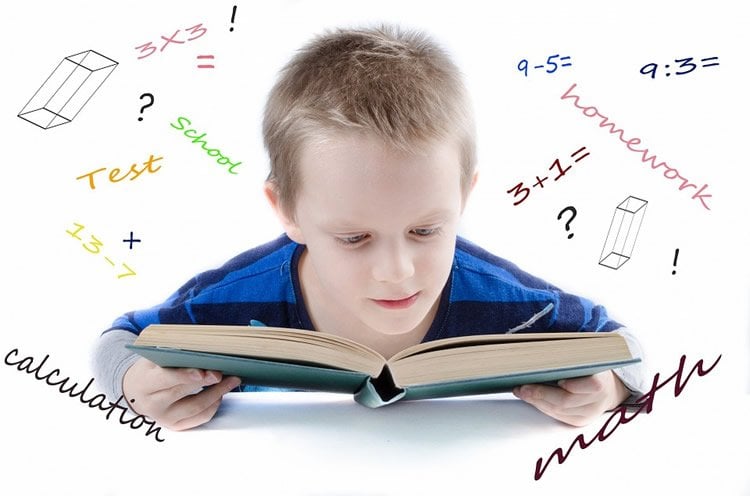Summary: Researchers have developed a new theory of how developmental math disability occurs.
Source: Georgetown University Medical Center.
Children differ substantially in their mathematical abilities. In fact, some children cannot routinely add or subtract, even after extensive schooling. Yet the causes of these problems are not fully understood. Now, two researchers, at Georgetown University Medical Center and Stanford University, have developed a theory of how developmental “math disability” occurs.
The article, in a special issue on reading and math in Frontiers in Psychology, proposes that math disability arises from abnormalities in brain areas supporting procedural memory. Procedural memory is a learning and memory system that is crucial for the automatization of non-conscious skills, such as driving or grammar. It depends on a network of brain structures, including the basal ganglia and regions in the frontal and parietal lobes.
The procedural memory system has previously been implicated in other developmental disorders, such as dyslexia and developmental language disorder, say the study’s senior researcher, Michael T. Ullman, PhD, professor of neuroscience at Georgetown.
“Given that the development of math skills involves their automatization, it makes sense that the dysfunction of procedural memory could lead to math disability. In fact, aspects of math that tend to be automatized, such as arithmetic, are problematic in children with math disability. Moreover, since these children often also have dyslexia or developmental language disorder, the disorders may share causal mechanisms,” he says.
The study’s lead author, Tanya M. Evans, PhD, who specializes in reading and math, was a graduate student at Georgetown. Evans is currently a postdoctoral research fellow at Stanford University.
Ullman says that their theory, called the procedural deficit hypothesis of math disability, “offers a powerful, brain-based approach for understanding the disorder, and could help guide future research.” The paper shows that previous findings are consistent with the theory, and lays out specific predictions that can be thoroughly tested through subsequent research.
To date, several other explanations of math disability have been suggested, such as deficits in spatial short-term memory, which could cause difficulties keeping numbers in mind. However, Evans says “other accounts do not generally explain math disability in terms of underlying brain structures, though the disorder must ultimately depend on aberrations in the brain.”

Ullman and Evans say that learning math likely depends on the brain’s two primary learning and memory systems — not just procedural memory, but also declarative memory, where conscious knowledge is learned. “We believe that learning math is likely similar to learning other skills,” Evans says. “For example, declarative memory may first be used to consciously learn how to drive, but then with practice driving gradually becomes automatized in procedural memory. However, for some children with math disability, procedural memory may not be working well, so math skills are not automatized.”
“Various domains, including math, reading, and language, seem to depend on both declarative and procedural memory. Evidence suggests that when procedural memory is impaired, children may have math disability, dyslexia, or developmental language disorder, though declarative memory often compensates to some extent,” Ullman says. “We believe that understanding the role of memory systems in these disorders should lead to diagnostic advances and possible targets for interventions.”
Source: Karen Teber – Georgetown University Medical Center
Image Source: NeuroscienceNews.com image is in the public domain.
Original Research: Full open access research for “An Extension of the Procedural Deficit Hypothesis from Developmental Language Disorders to Mathematical Disability” by Tanya M. Evans and Michael T. Ullman in Frontiers in Psychology. Published online September 15 2016 doi:10.3389/fpsyg.2016.01318
[cbtabs][cbtab title=”MLA”]Georgetown University Medical Center. “Math Difficulties May Reflect Problems in a Critical Learning System in the Brain.” NeuroscienceNews. NeuroscienceNews, 15 September 2016.
<https://neurosciencenews.com/math-learning-neuroscience-5052/>.[/cbtab][cbtab title=”APA”]Georgetown University Medical Center. (2016, September 15). Math Difficulties May Reflect Problems in a Critical Learning System in the Brain. NeuroscienceNews. Retrieved September 15, 2016 from https://neurosciencenews.com/math-learning-neuroscience-5052/[/cbtab][cbtab title=”Chicago”]Georgetown University Medical Center. “Math Difficulties May Reflect Problems in a Critical Learning System in the Brain.” https://neurosciencenews.com/math-learning-neuroscience-5052/ (accessed September 15, 2016).[/cbtab][/cbtabs]
Abstract
An Extension of the Procedural Deficit Hypothesis from Developmental Language Disorders to Mathematical Disability
Mathematical disability (MD) is a neurodevelopmental disorder affecting math abilities. Here, we propose a new explanatory account of MD, the procedural deficit hypothesis (PDH), which may further our understanding of the disorder. According to the PDH of MD, abnormalities of brain structures subserving the procedural memory system can lead to difficulties with math skills learned in this system, as well as problems with other functions that depend on these brain structures. This brain-based account is motivated in part by the high comorbidity between MD and language disorders such as dyslexia that may be explained by the PDH, and in part by the likelihood that learning automatized math skills should depend on procedural memory. Here, we first lay out the PDH of MD, and present specific predictions. We then examine the existing literature for each prediction, while pointing out weaknesses and gaps to be addressed by future research. Although we do not claim that the PDH is likely to fully explain MD, we do suggest that the hypothesis could have substantial explanatory power, and that it provides a useful theoretical framework that may advance our understanding of the disorder.
“An Extension of the Procedural Deficit Hypothesis from Developmental Language Disorders to Mathematical Disability” by Tanya M. Evans and Michael T. Ullman in Frontiers in Psychology. Published online September 15 2016 doi:10.3389/fpsyg.2016.01318






